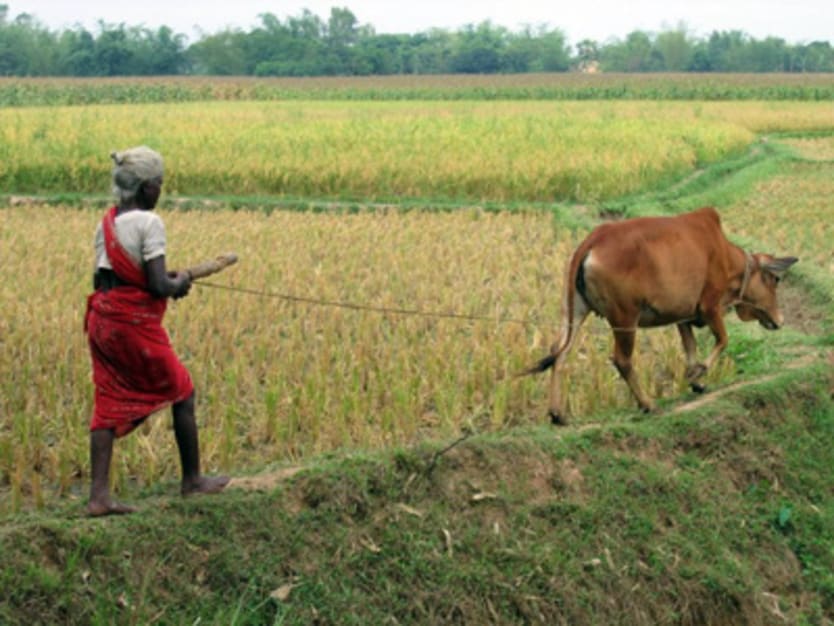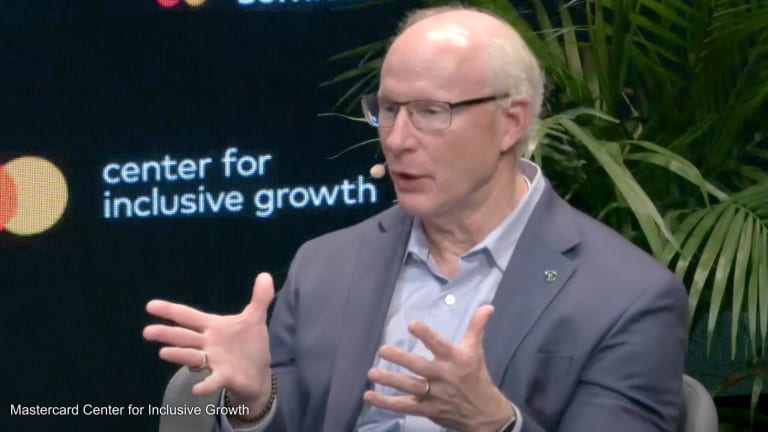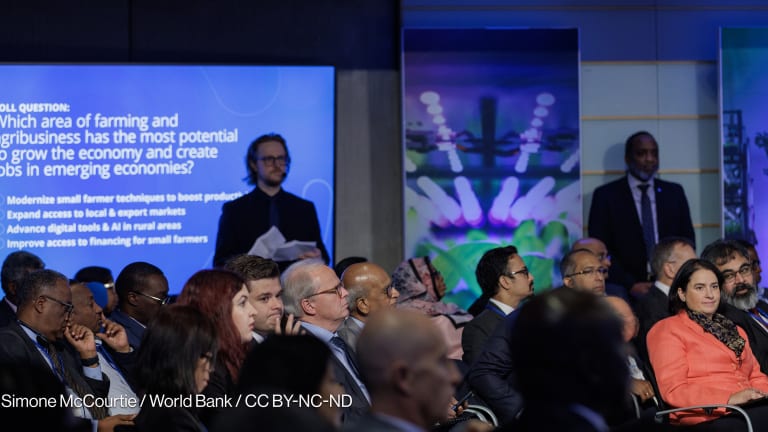
In Benin, local volunteers walk through rural farmlands and pastures demarcating property boundaries with high-tech receivers on poles and handheld devices twice the size of a television remote control. In Ghana, land surveyors armed with similar equipment and iPads interview occupants about land ownership and use. And in Burkina Faso, mappers are creating a national geographic positioning network that captures data from the global satellite system.
All over Africa and beyond, high-tech equipment is being used to catalogue claims to land with near pinpoint precision — sometimes up to less than a foot — and often with a singular goal in mind: sustainable economic development. That is because with secure land rights, farmers and others are more likely to develop their property, plant crops with longer time horizons, or use land as collateral for bank loans to improve their standard of living.
“If you have a document that says you own land, that is property,” said Matt Delano, business area director for Trimble Land Administration Solutions, a high-tech company that provides geo-spacial positioning and software technology for land surveying, among other services.
“If it’s property, you can buy it, you can sell it. It now has value,” explained Delano. “If I have protection from the government that says that land is mine, I’m much more likely to invest in that land — to clear it and plant it, or build improvements to it, a home or a well.”
Trimble and other companies have been helping to map Africa and other parts of the globe using aerial and satellite imagery, handheld devices and other instruments, as well as a broad range of software that is used not only to measure parcel boundaries, but also to capture data on land improvements, land use and land tenure.
Such findings have helped to revolutionize land rights in places that have never before relied on maps to determine who has rightful access to or ownership of land. The result has been, in many places, slow but steady improvement in people’s economic well-being.
“People get cows because they have land they can fence off,” said Rena Singer, director of communications at Landesa, a rural development institute. “People are terracing their land. They are using improved fertilizer. These are things we see wherever [secure land tenure] happens. We see a huge increase in the amount of money they are able to get out of their land.”
It is estimated that roughly 2.5 billion people around the globe survive on less than $2 a day; Landesa reckons that about three quarters of them live in rural areas and are dependent on the land they cultivate to survive. The company also estimates that 1 billion do not have secure rights to the land they till.
Catalyst for development
There is a wealth of evidence that secure land rights can increase food production, but one of the earliest indicators came from the former Soviet Union, development experts said. In 1990, private micro-farms accounted for about 2 percent of the country’s arable land and produced 27 percent of the agriculture output; today, they account for 14 percent of cultivated land and produce more than half the agriculture.
“At some point, the light dawned on us that maybe this wasn’t just an interesting phenomenon in collectivized agriculture but also relevant to traditional agriculture countries as well,” said Roy Prosterman, Landesa’s founder and chairman emeritus.
India offers another glimpse of micro-plots at work to spur economic development. The country is home to millions of smallholder farmers — about 80 percent of rural households own less than 1 hectare of land, according to a 2003 national survey. In the state of Odisha, 50 percent of village households did not have title to the land they live on, while in Andhra Pradesh, nearly 2 million rural households had insecure land rights, according to the survey.
Landesa works with governments in several Indian states on a program to allocate micro-plots about the size of a tennis court to thousands of landless farmers. Development experts say formalizing the land rights of people working the soil can spur economic development.
“It’s a really powerful approach, getting them access to an asset in the first place, an asset that they can use to improve their economic well-being,” said Jolyne Sanjak, managing director of the Millennium Challenge Corp.’s technical services division.
But there is much else that the global aid community can do to encourage economic growth through the increased recognition of land rights, according to development experts.
Work with international bodies to create frameworks that recognize that land rights are tied to economic development
The link between secure land rights and economic development is becoming more and more recognized in the international development community — so much so that there is growing momentum in the international development community for including land rights as a goal in the post-2015 development agenda, the successor to the U.N. Millennium Development Goals that have guided development priorities until now.
Hien Tran, director of global advocacy at Landesa, has been working to ensure that the international community recognizes the centrality of land rights as world leaders craft the post-2015 agenda. She sees a clear connection between the inclusion of land rights in development frameworks and economic development.
“More resources will go toward land tenure issues and there will be more projects and interventions if the need for land rights is included in the global agenda and recognized by world leaders as one of the key things we need to address,” Tran predicted.
Work with governments to synthesize customary and statutory land tenure laws into one cohesive law
In many developing countries, land laws are derived from statutes and from tribal custom. Development agencies can work with governments to help synthesize these laws so that it is clear who has rights to land tenure and use.
MCC is one such organization and is working in about a dozen countries on land projects dedicated to reforming to land tenure, including legal and regulatory reforms, institutional capacity building, and the formalization of land rights.
An MCC project in Benin, for instance, is helping to synthesize land laws that are derived both from French colonial law and from customary rules that are often handed down orally from one generation to the next.
“There are almost no existing records, so there is a lack of clarity over who owns what,” said Rick Gaynor, MCC’s director of property rights and land policy.
As Benin began to develop, that lack of clarity became a constraint on investment.
“There were multiple sets of rules at play,” said Sanja. “Over time, when markets start to development, the ability of those systems to run in parallel starts to break down.”
Ensure that governments recognize so-called “secondary rights” to land tenure
Often it takes more than just demarcating tribal lands or titling individual plots to smallholder farmers to boost economic growth. People need to have so-called “secondary rights” to the land as well: the right to gather fallen branches, for instance, pick mushrooms or cut trees.
“Some of the poorest people may depend for a good part of their livelihood on various secondary rights,” Prosterman said.
One solution is to delineate the external boundaries of communal land and then leave the internal divisions up to the tribe or clan whose rights to it have been recognized.
“Otherwise, an outsider may come in and say, this is public land. You don’t own it, you’re squatting,” Prosterman said. “But this is land these people have been using for generations. It’s important that laws protect the rights of traditional users.”
Publicity about the new laws
Sometimes members of local communities are unaware of new laws or regulations that strengthen their claims to the land. Development agencies often work to ensure that people know their rights.
When Kenya passed sweeping land reforms, Landesa informed not only villagers in rural areas, but also government officials and judges. In Mali, MCC worked with the government to support an irrigation project that allocated land to farmers and provided them with startup inputs. In Burkina Faso, Madagascar, Mozambique and elsewhere, MCC helped the government reform land tenure laws and inform the public of changes to their land rights.
“Empowering citizens is really at the heart of what we do,” noted Gaynor. “That means making them aware of their rights, aware of the laws and policies that relate to land, creating responsive and accountable institutions. That is the focus of our work and what ends up driving economic growth in the end.”
Support projects that encourage long-term investment
A growing body of evidence shows that when farmers feel secure in their rights to land, they grow crops that require a longer time horizon to bear fruit, development experts say. This often leads to greater crop diversification, tree planting, and other measures that improve agricultural output over time and lead to greater long-term economic development .
In Ethiopia, for instance, donor projects to plant trees following droughts in the 1980s largely failed because the ownership of the trees was not well defined, so farmers were not interested in maintaining them, said Chris Reij, a sustainable land management specialist and senior fellow at the World Resources Institute.
By contrast, farmers in the Sahel, where farmers have secure access to communal lands, Reij estimated they had successfully maintained 200 million new trees in the last 20 years, leading to richer soil and less wind erosion. In Niger and Burkina Faso, farmers dug in hardened soil to plant manure that would soften the ground, eventually restoring some 500,000 hectares of barren and degraded land.
“It required a lot of labor. If they didn’t have secure rights, they wouldn’t have been motivated to invest all their labor and energy in it,” Reij said. “Land tenure is a very complex and political issue but very vital for the future.”
Want to know more? Check out Land Matters, a new campaign to showcase innovative solutions in the areas of food security, economic development, conservation and more.








